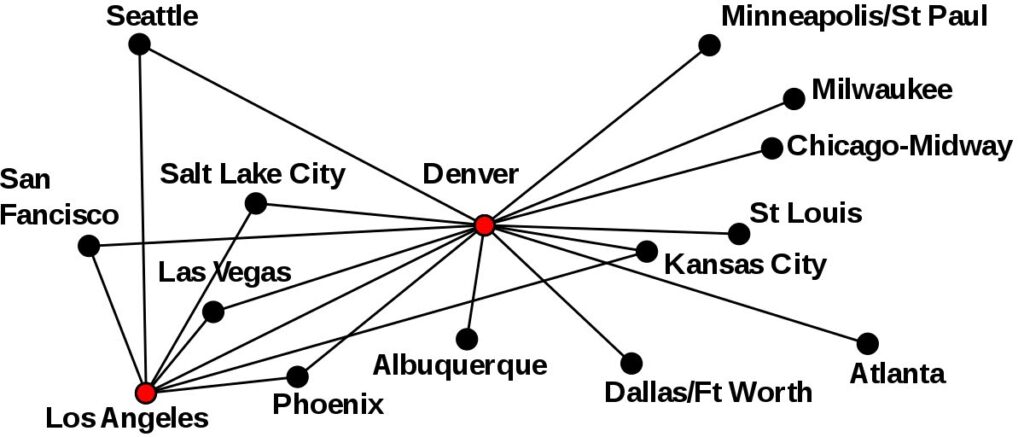Airlines and hub-and-spoke operations

An airline hub is an airport used by airlines to concentrate passenger traffic and serves as transfer points for inbound flights with passengers from several spoke cities into the hub airport. After a brief transit, outbound flights transport passengers from the hub to other spoke cities or to another hub airport. A hub creates economies of scale that allow an airline to serve city-pairs that would otherwise be uneconomical if served on a point-to-point basis with nonstop flights.
By definition, a hub is the central part of a wheel, rotating on an axle, and from which the spokes radiate.
The term crept into the aviation vocabulary after the deregulation of the US airline industry when Delta Airlines began to experiment with the hub-and-spoke system by providing service to remote spoke cities from its Atlanta hub. Many other airlines followed suit and began to establish their own hub-and-spoke operations as some point-to-point routes were not profitable due to low load factors.
There are several models of the hub-and-spoke system based on the unique characteristics of an airline-route network and which offer passengers a one-stop service to a wide array of destinations.
A fortress hub exists when an airline controls a significant majority of the market at a hub airport. Competition is particularly difficult at fortress hubs because of an airline’s dominance at the hub. High domestic connectivity in the US is achieved through an airport’s location and its hub dominance. Airlines can monopolise their fortress hubs allowing them to easily increase fares as passengers have limited options.
Additionally, flag-carriers enjoy hub dominance at the main international airports of their countries. Examples include American Airlines at Dallas/Fort Worth, Lufthansa at Frankfurt, Emirates in Dubai, Air Canada in Toronto, British Airways in London-Heathrow, Copa Airlines in Panama City, Qantas Airlines in Sydney and Singapore Airlines in Singapore.
A primary hub is the main hub for an airline. However, as an airline expands operations at its primary hub, it sometimes experiences capacity limitations and elect to open secondary hubs. Examples of secondary hubs are British Airways' hub at London-Gatwick and Lufthansa's hub at Munich. By operating multiple hubs, airlines can expand their geographic reach. They can also better serve spoke-to-spoke-markets, providing more itineraries and connections.

As a hub's capacity becomes exhausted during peak periods of the day, airlines have to shift traffic to a reliever hub which has the potential to serve several functions for an airline. It can bypass the congested hub and absorb excess demand for flights that could otherwise not be scheduled at the congested hub.
Examples of this model is the use of La Guardia Airport by Delta Airlines and American Airlines as a domestic hub in New York due to capacity and slot restrictions at their hubs at John F Kennedy (JFK). Many regional flights operate out of La Guardia, while most international flights operate out of JFK.
A scissors hub is an airport where many flights with passengers travelling to one destination all land and deplane passengers simultaneously. After a brief passenger-transit period, all the passengers board one aircraft for the final destination. Air India operated a scissors hub at London's Heathrow Airport, where passengers from Delhi, Ahmedabad, and Mumbai can continue out of London on an Air India flight to Newark, New Jersey.
The process was reversed for Air India flights originating in Newark with passengers for several destination in India. The term scissors was coined because the route map resembles the shape of a pair of scissors.
A cargo hub is an airport that primarily is operated by a cargo airline that uses the hub-and-spoke system. In the US, the largest cargo-hub airports are traditionally in the Midwest. In April 1973, FedEx commenced operations based on a hub-and-spoke operation. Packages would be collected from outlying spoke cities and brought by air to its superhub at Memphis, Tennessee where the packages would be sorted and delivered by air to the destination spoke cities.
Today, FedEx operates several secondary hubs to serve regional high-demand destinations because shipping packages through its main hub would increase fuel burn and transit time for the delivery of cargo. An example of this would be FedEx transiting packages through Changi Airport in Singapore instead of sending deliveries through its Memphis superhub.
The selection of airports by airlines as hubs is primarily based on its strategic geographical location within the airlines’ route networks, airport characteristics and the expeditious facilitation of passenger transfers. Secondary considerations are airport-user charges, ground-handling and airport congestion.
Today, most of the major international airlines have hub-and-spoke operations with some airlines such as Delta Airlines having several hubs in their route network.
Finally, airlines create hubs based on operating economics and airports facilitate hubs through cost-effective services.

Comments
"Airlines and hub-and-spoke operations"